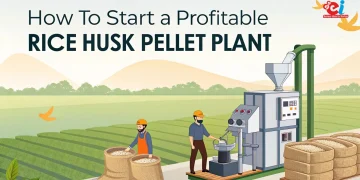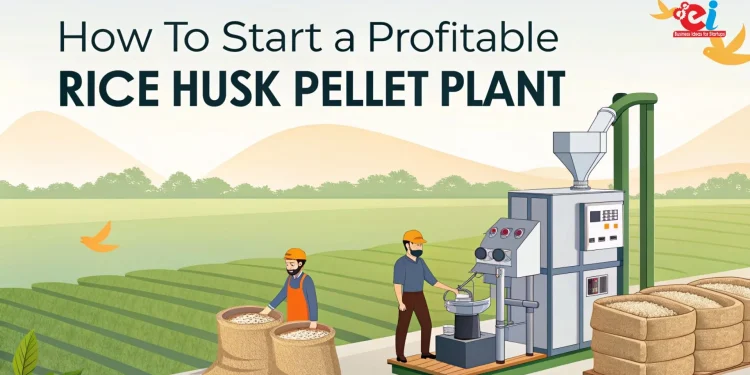With concerns around climate change, fossil fuel depletion, and the increasing cost of energy, there is a global shift toward renewable and sustainable sources of energy. One of the most promising solutions coming from the agricultural sector is the pelletization of rice husks. Compact biofuels made from the outer shell of rice grains are a novel source of energy. They serve as an economical, renewable alternative to coal, LPG, and diesel for industrial and domestic heating purposes.
India, being the second largest producer of rice globally, generates millions of tones of rice husk pellet every year. The agricultural residue, if not utilized properly, tends to be burned in open fields, posing a dire threat to air quality. With advancements in biomass pelletizing technology and an ever-increasing market for green energy, rice husk can be converted into a commercially viable fuel source. The pelletization of agricultural waste such as rice husks, will not only create new job opportunities in rural areas but also decrease reliance on imported fossil fuels, strengthen the circular economy, and improve environmental sustainability.
Examining Rice Husk as a Feedstock
Rice husk is a hard and fibrous protective structure of rice grains and is a byproduct of rice milling. It constitutes roughly 20% of the paddy weight. They are usually regarded as agricultural waste which cannot be put into direct use due to low bulk density, high silica content, abrasiveness, and other affecting factors. However, rice husk can be transformed into pellets which makes it an easily manageable and valuable fuel. Pellets made from rice husk require less combustion, are clean, and have a high calorific value.
It is estimated that India produces over 40 million tonnes of rice husk yearly. This indicates that rice husk can be effortlessly procured as a biomass source. Major rice exporting states like Punjab, Haryana, Uttar Pradesh, West Bengal, Andhra Pradesh, Chhattisgarh, and Tamil Nadu serve as regions where husk accumulates. Its almost zero or low price makes it economically appealing to biomass industries. Also, the lignocellulosic structure aids in no need for synthetic binders which eliminates the use of strong adhesive in non-palatable cases.
Creating Rice Husk Pellets
The process starts with the collection of rice husk from rice mills as a by-product of rice milling. The husk is then dried since excess moisture may impede the subsequent pelletizing step as well as combustion efficiency. Driers that are used will depend on the scale and location of the operation the husk was sourced, and may include mechanical driers as well as sun drying.
Following the above step, the rice husks undergo grinding in either a hammer mill or crushing equipment. This process is meant to enhance the consistency of both the size of the husk pellets in addition to the uniformity of compaction in the later step of pelletizing. Once the husk has been ground, it is sent to a pellet mill. In the pellet mill, the husk gets compressed under high pressure and temperature through a die.
While this is happening, particles merge together thanks to the softening natural lignin in the husk which then forms solid cylindrical pellets of approximately 6 to 10 mm in diameter together with the husk. The soft and hot pellets produced through this method tend to be fragile. Hence, they must be passed through a cooling system to harden and stabilize.
The last step is grading the product to remove fines or broken pellets and storing it for future sale. Rice husk pellets are usually packed in bags of 25 kg or 50 kg for retail or wholesale trade and stored in silos and bulk containers for large industrial clients. The product has low moisture content, is easy to store, transport, and dense, making it ideal for automated combustion systems.
Related: Transforming Rice Husk into Profitable Particle Boards
Uses and Applications of Rice Husk Pellets
Rice husk pellets are primarily being used as clean and efficient thermal energy. They are extensively used in industrial boilers as well as heating systems, dryers, and furnaces. Brick kilns, textile dyeing units, tea processing factories, paper mills, and agro-processing industries are known to benefit from using these pellets in place of coal and diesel. Rice husk pellets are advantageous because they are renewable energy sources that are lower in price than traditional fuels, which greatly reduces operational fuel costs due to carbon tax exemptions in many places.
The generation of power has seen an increase in the use of rice husk pellets in biomass thermal plants as a primary fuel or in combination with coal firing to lower carbon emissions. Due to their ease of handling and constant energy yield, they are ideal for perpetually bolstering combustion systems.
In rural areas, where LPG is unavailable or costly, the domestic application of rice husk pellets is increasing. Specially designed household rice husk pellet stoves provide a sustainable solution for cooking and heating by burning rice husk pellets cleanly and efficiently.
Moreover, the ash from combusted rice husk pellets contains significant amounts of silica which can be used to create cement, concrete, and insulating materials, or even be utilized for amending soil in agriculture. This elevates the byproduct from mere fuel to an asset in industrial symbiosis and zero-waste initiatives.
Environmental and Economic Benefits
The environmental benefits of rice husk pellets are of great value. First, they provide a means to utilize an agricultural byproduct which would otherwise contribute to environmental pollution through burning in open fields.
Secondly, they are classified as carbon-neutral because the carbon dioxide released during combustion is approximately equal to the amount absorbed by the rice plant during its growth phase. This means that rice husk pellets are ideal substitutes for fossil fuels in emission sensitive uses and in projects aimed at generating carbon credits.
By utilizing rice husk pellets, industries are able to reduce their energy expenditures by 20% to 40% compared to using conventional fuels. This is an economic benefit. The raw material is almost always available at little or no cost, and the production process requires significantly less energy than the refining of fossil fuels, therefore the cost of pelletized biomass is always economical and predictable. This results in significant advantages for entrepreneurs who seek to establish businesses in highly-demanded sectors such as agriculture, hospitality, renewable energy, and manufacturing.
Rural employment also benefits from this. There is a need for labor for collection, drying, grinding, pelletizing, packaging, and even transport of rice husk. The planting of pellet plants in rice producing regions creates jobs in otherwise economically depressed areas which helps stem the rural-urban drift and improve the economy.
Establishing a Rice Husk Pellet Plant
In the setting of a rice husk pellet manufacturing unit, great care needs to be taken in the matters of location, selection of technology, linkage to markets, plant size, and even capacity. A good location would be near to rice mills or paddy processing cluster where there is ready supply of raw husk and lower costs of transport.
The presence of water, electricity, and even skilled labor affect the selection of the site. The investment on the initial infrastructure and automation for a one ton per hour small scale unit is estimated between ₹50 lakh and ₹1 crore.
The major needed technologies include a size reduction hammer mill or a crusher, a moisture content drying system, a cooling system, screening machine, packaging machine, and even a pellet mill with varying dies for different pellet sizes. For dust management, conveyors, control panels, and dust collectors are required in order to maintain safe and smooth operations. In the case of large units intending to bid for Export and Industrial Supply Contracts, automated systems alongside storage silos become imperative.
There has to be a constant demand, efficient operations, and strong connections with buyers in order to make the feasibility of the financial aspect of the Plant. Revenue is guaranteed along with plant viability through bulk contracts with Industrial Users, tie ups with companies that use biomass energy, and through government schemes that support renewable energy.
With the right strategy, branding, and a reliable standard of quality control, these rice husk pellets could even be marketed to buyers in parts of Europe, South Korea, Japan, and other western regions as they offer incentives for importing biomass due to clean energy mandates which makes them ideal prospects.
Regulatory Compliance and Certification
While rice husk pellet plants are less regulated than chemical or thermal plants, they must still comply with environmental standards, especially related to air quality and dust emissions.
The facility should be registered under the local Pollution Control Board, and dust collection systems must be installed to minimize particulate matter emissions. For export-oriented units, certifications such as ISO 17225-2 for biomass solid fuels, CE certification for equipment, and sustainability documentation may be required.
In India, support can be sought under the Ministry of New and Renewable Energy (MNRE) and MSME schemes for biomass energy development. Entrepreneurs can also explore carbon credit monetization opportunities under verified carbon standard programs by ensuring traceable and efficient production practices.
Related: Starting a Profitable Silica Gel Business from Rice Husk
Role of NPCS in Project Implementation
Entrepreneurs venturing into rice husk pellet production can benefit significantly from expert consultancy services provided by NIIR Project Consultancy Services (NPCS). With decades of experience in biomass-based project development, NPCS offers comprehensive support including market research, technical feasibility, financial projections, plant layout design, raw material sourcing strategies, and end-user identification.
NPCS’s detailed project reports offer clarity on machinery costs, breakeven analysis, working capital needs, operating margins, and profitability forecasts. Whether for a new startup, an extension of an agro-processing business, or a sustainable energy initiative, NPCS provides customized guidance to ensure smooth execution and long-term success.
Conclusion
The transformation of rice husk into bioenergy pellets represents one of the most sustainable and economically sensible innovations in the renewable energy sector. It addresses the dual challenge of agricultural waste management and energy security while contributing positively to rural development, industrial cost reduction, and climate resilience.
With abundant raw material availability, growing industrial demand, and supportive policy frameworks, the rice husk pellet industry offers a powerful platform for green entrepreneurship. For those looking to invest in a business that is as profitable as it is sustainable, rice husk pellets are a clear path forward. Backed by experienced partners like NIIR Project Consultancy Services, setting up a rice husk pellet plant becomes a well-planned and rewarding journey into the future of bioenergy.


























